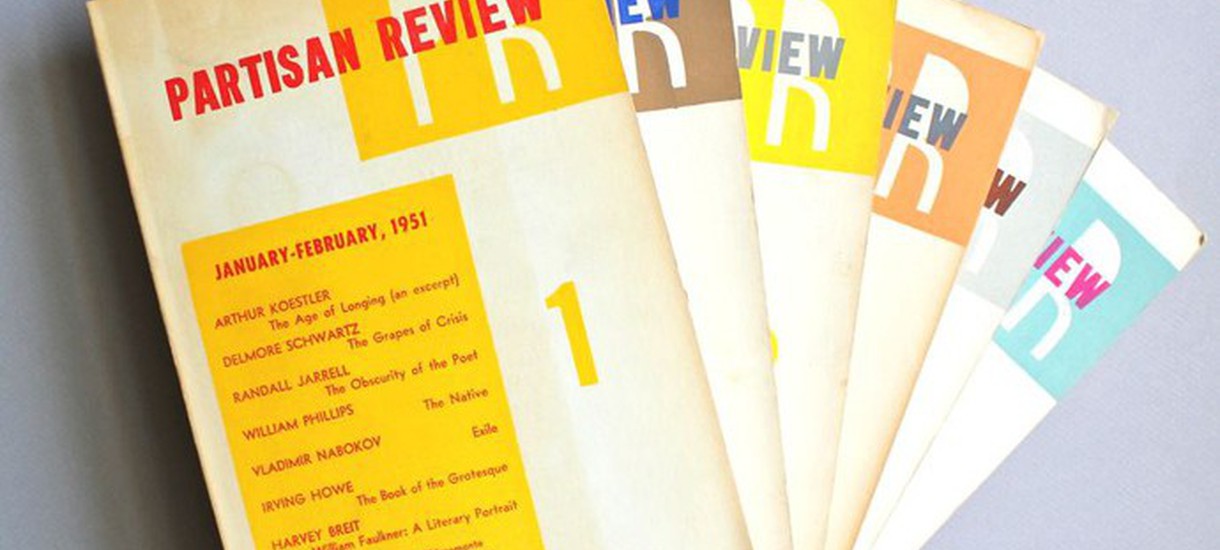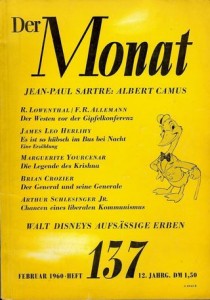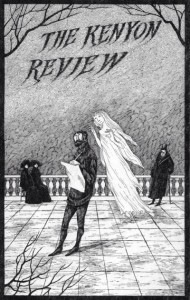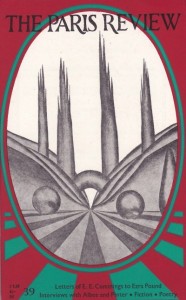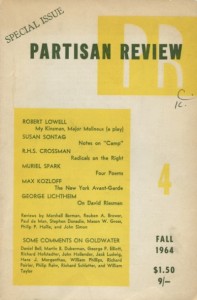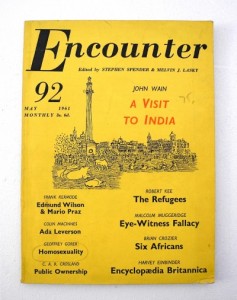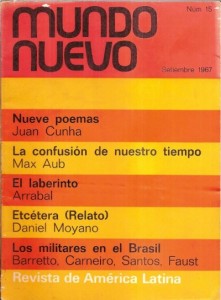Patrick Iber
In May of 1967, a former CIA officer named Tom Braden published a confession in the Saturday Evening Post under the headline, «I’m glad the CIA is ‘immoral.’». Braden confirmed what journalists had begun to uncover over the previous year or so: The CIA had been responsible for secretly financing a large number of “civil society” groups, such as the National Student Association and many socialist European unions, in order to counter the efforts of parallel pro-Soviet organizations. “[I]n much of Europe in the 1950’s,” wrote Braden, “socialists, people who called themselves ‘left’—the very people whom many Americans thought no better than Communists—were about the only people who gave a damn about fighting Communism.”
The centerpiece of the CIA’s effort to organize the efforts of anti-Communist artists and intellectuals was the Congress for Cultural Freedom. Established in 1950 and headquartered in Paris, the CCF brought together prominent thinkers under the rubric of anti-totalitarianism. For the CIA, it was an opportunity to guarantee that anti-Communist ideas were not voiced only by reactionary speakers; most of the CCF’s members were liberals or socialists of the anti-Communist variety. With CIA personnel scattered throughout the leadership, including at the very top, the CCF ran lectures, conferences, concerts, and art galleries. It helped bring the Boston Symphony Orchestra to Europe in 1952, for example, as part of an effort to convince skeptical Europeans of American cultural sophistication and thus capacity for leadership in the bipolar world of the Cold War. By purchasing thousands of advance copies that it gave away for free, the CCF supported the publication of many of the era’s anti-Communist classics, such as Milovan Djilas’ The New Class. But its most impressive achievement was a stable of sophisticated literary and political magazines. The CCF’s flagship journal was the London-based Encounter, but it also published Preuves in France, Tempo Presente in Italy, Forum in Austria, Quadrant in Australia, Jiyu in Japan, and Cuadernos and Mundo Nuevo in Latin America, among many others.
Through the CCF, as well as by more direct means, the CIA became a major player in intellectual life during the Cold War—the closest thing that the U.S. government had to a Ministry of Culture. This left a complex legacy. During the Cold War, it was commonplace to draw the distinction between “totalitarian” and “free” societies by noting that only in the free ones could groups self-organize independently of the state. But many of the groups that made that argument—including the magazines on this left—were often covertly-sponsored instruments of state power, at least in part. Whether or not art and artists would have been more “revolutionary” in the absence of the CIA’s cultural work is a vexed question; what is clear is that that possibility was not a risk they were willing to run. And the magazines remain, giving off an occasional glitter amid the murk left behind by the intersection of power and self-interest. Here are seven of the best, ranked by an opaque and arbitrary combination of quality, impact, and level of CIA involvement.
7. The New Leader
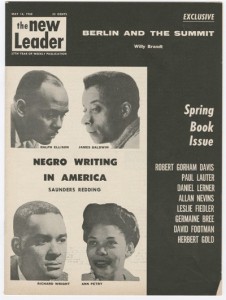
The New Leader was founded in the nineteen twenties as a voice for American socialism, but by the dawn of the Cold War, it focused incessantly on establishing the totalitarian and imperialist character of the Soviet Union. During The New Leader’s heyday in the late forties and early fifties, its editor was Sol Levitas. The New Leader’s relationship with the CIA wasn’t always easy; the CIA actually thought that Levitas’s anti-Communism was too ferocious, unrelenting, and “conservative.” The New Leaderargued consistently that Soviet society was totalitarian in nature and Communism everywhere was controlled by the Kremlin, while the CIA wanted a more moderate and “sophisticated” voice that would appeal to the European left. In spite of its strident anti-Communism, The New Leader remained progressive in the context of U.S. domestic politics; it was one of the first publications to publish Martin Luther King, Jr.’s Letter from a Birmingham Jail.
6. Der Monat
Der Monat (“The Month”) was a German magazine founded in 1948 by New Yorker Melvin Lasky; the magazinewas his attempt to put his desired politics of “cultural freedom” into action. The year before, Lasky had caused a stir at the First German Writers’ Congress when he brought up the persecution and suppression of writers in Russia. He argued that those in the West should have sympathy for Russian writers, who had to continually worry about secret police actions and that shifting party doctrine might brand them overnight as “decadent counterrevolutionary tools of reaction.” Originally published under the authority of the U.S. military government in divided Germany, it became an important template for the magazines of the Congress for Cultural Freedom and was later incorporated into that network. Many have suspected Lasky himself of being a CIA agent, he denied it to the death.
5. Kenyon Review
Probably the finest literary magazine in American history, the Kenyon Review was founded by John Crowe Ransom in 1939. The intellectuals and CIA officers who ran the Congress for Cultural Freedom loved Ransom, and used him and his literary networks to locate promising students and literary friends that it could recruit to work for it. Even Ransom’s technique of “New Criticism,” seen as a quintessentially conservative Cold War form of analysis because it eschewed examination of the social and political context of literary works, has sometimes been compared to the work of espionage, by which careful reading can unearth hidden plans and meanings.
A partial list of the nearly insuperable roster of the Kenyon Review’s authors includes Robert Lowell, T.S. Eliot, Flannery O’Connor, Thomas Pynchon, Nadine Gordimer, Randall Jarrell, and Joyce Carol Oates. It, as well as others, including the Hudson Review, the Sewannee Review, Poetry, Daedalus, Partisan Review, and The Journal of the History of Ideas, had hundreds and even thousands of copies purchased for distribution abroad by the Congress for Cultural Freedom, and sometimes received grants more directly. This was significant help for a small magazine; Kenyon Reviewhad to close for a decade beginning in 1969, just a few years after revelations of CIA involvement forced such support to be discontinued. Robie Macauley, who had been recruited by the CIA some years earlier, succeeded Ransom as editor of the Kenyon Review.
4. Paris Review
Of all the publications on this list, the Paris Review may be the one with the weakest connection to the CIA. Like the Kenyon Review, the Paris Reviewis one of the twentieth century’s finest literary magazines. Edited by George Plimpton, it published the likes of Italo Calvino, Samuel Beckett, Philip Roth, V.S. Naipaul, Jack Kerouac, Donald Barthelme, Jeffrey Eugenides, and Jonathan Franzen. Peter Matthiessen, one of the co-founders of the Paris Review, had been recruited into the CIA and the magazine initially served as part of his cover. But he maintained that the connections ended there, and that the Paris Review was certainly not a part of the Congress for Cultural Freedom. For a 2012 article published in Salon, however, Joel Whitney examined the archives of the Review and found a deeper-than-acknowledged relationship with the CCF and, therefore, the CIA. Some of this was inevitable: They shared a Parisian milieu and had common interests. But the record clearly shows that the Paris Review benefited financially from selling article reprints to CCF magazines. This was far from the CCF’s direct participation in management of Der Monat or Encounter, but the Paris Review did derive some benefit from the CIA, and there is circumstantial evidence that this affected the choices of authors for its interview series. In a way, the Paris Review case shows how difficult it was for “apolitical” highbrow literary periodicals to get through that period of the Cold War without some form of interaction with the CIA.
3. Partisan Review
Partisan Review was, for a few short years, one of the finest magazines produced. In the late thirties and early forties, when it was funded primarily by the painter George Morris, it was controlled by an avant-garde group of “literary Trotskyists” interested in fusing cultural modernism with political anti-Stalinism. Delmore Schwarz’s well-known short story, “In Dreams Begin Responsibilities,” was published there in 1937—and that issue alone contains work by Wallace Stevens, Edmund Wilson, James T. Farrell, Pablo Picasso, James Agee, Mary McCarthy, and Dwight Macdonald. George Orwell was another frequent contributor, and Partisan Review was first to publish many classic essays of criticism, including Clement Greenberg’s “Avant Garde and Kitsch,” and Susan Sontag’s “Notes on ‘Camp.’” The magazine, like so many, peaked early in its publication history. By the time that it received CIA support in the nineteen fifties, it had lost some of its initial energy, and its politics were growing increasingly “neoconservative,” although it continued on as a “little magazine” until 2003. (Boston University has made every issue of Partisan Review fully available online.)
2. Encounter
London-based Encounter was considered the crown jewel of the Congress for Cultural Freedom’s publishing program. Created in 1953, Encounter was edited by Irving Kristol and later, Melvin Lasky, while the literary pages were for many years curated by the poet Stephen Spender. It regularly published both British and American writers, including Isaiah Berlin, Mary McCarthy, Hugh Trevor-Roper, W.H. Auden, Daniel Bell, Arthur Schlesinger, Jr., Bertrand Russell, Stuart Hampshire, and John Kenneth Galbraith. It is often credited with helping shift the British intellectual scene away from socialism and towards an “Atlantic,” pro-U.S. outlook. Edward Shils worked out his ideas of “The End of Ideology” in its pages; C.P. Snow published his essay on the “two cultures” of the natural sciences and the humanities there; and it published Nancy Mitford’s “The English Aristocracy,” the classic essay about “U and non-U” describing differences in pronunciation between British classes. It also helped introduce English readers to authors like Jorge Luis Borges, and frequently featured the witty and erudite anti-Communism of Leszek Kolakowski. (See his “How to be a Conservative-Liberal Socialist”—the founding document of what he describes as “the Mighty International that will never exist,” for a reasonable distillation of the magazine’s ideology.) Encounter’s strength was such that it survived the CIA scandals of the late sixties and continued publishing on its own into the early nineties. The entire run of Encounter is fully available online.
1. Mundo Nuevo
The Congress for Cultural Freedom’s programs were not limited to Europe, and in the mid-sixties, it was trying to shift its Latin American operation from one that was ineffectively fighting the relatively unimportant pro-Soviet Communist parties of the region to one that would subtly undermine the appeal of Fidel Castro’s Cuba. It closed one magazine, Cuadernos, in 1965, and launched Mundo Nuevo a year later to try to appeal to more left-wing writers. The initial director of Mundo Nuevo, the Uruguayan Emir Rodríguez Monegal, insisted that he was trying to broker peace in the Cultural Cold War and have an honest dialogue about art and politics in Cuba.
Like other magazines affiliated with the Congress for Cultural Freedom, Mundo Nuevo published essays critical of U.S. policy in Latin America and Vietnam. Its usefulness, from the U.S. government’s point of view, consisted in its defense of the responsibility of the artist as an independent critic of power, rather than part of a the machinery of revolutionary social transformation. Cuban intellectuals noted the magazine’s ties to the CCF and refused to participate; nonetheless, in its first few issues, Mundo Nuevo was an extraordinary success. Pablo Neruda, the Communist poet who only a few years earlier had been the subject of a CCF campaign to undermine his candidacy for the Nobel Prize, contributed several poems. There are interviews with Carlos Fuentes and Jorge Luis Borges, and fiction that would be foundational to the “boom” in Latin American letters from José Donoso and Guillermo Cabrera Infante. Most surprisingly, it published an early excerpt from the still unpublished One Hundred Years of Solitude, by Gabriel García Márquez. García Márquez, later famous for his close friendship with Fidel Castro, regretted his contribution when connections to the CIA were soon revealed. Nonetheless, José Donoso, in his memoir of the boom in Latin American literature, wrote that Mundo Nuevo was the “voice of Latin American literature of its time,” and at the center of a major phenomenon in world literature.
Taken from The Awl
